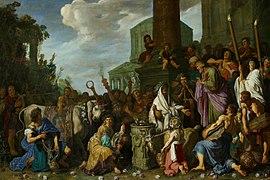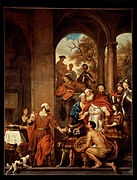
Gerbrand van den Eeckhout was a Dutch Golden Age painter and a favourite student of Rembrandt. He was also an etcher, an amateur poet, a collector and an adviser on art.

Joachim von Sandrart was a German Baroque art-historian and painter, active in Amsterdam during the Dutch Golden Age. He is most significant for his collection of biographies of Dutch and German artists the Teutsche Academie, published between 1675 and 1680.
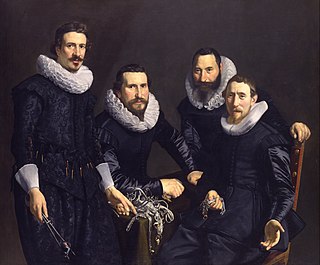
Thomas de Keyser was a Dutch portrait painter and a dealer in Belgium bluestone and stone mason. He was the most in-demand portrait painter in the Netherlands until the 1630s, when Rembrandt eclipsed him in popularity. Rembrandt was influenced by his work, and many of de Keyser's paintings were later falsely attributed to Rembrandt.

Emanuel de Witte (1617–1692) was a Dutch perspective painter. In contrast to Pieter Jansz Saenredam, who emphasized architectural accuracy, De Witte was more concerned with the atmosphere of his interiors. Though few in number, de Witte also produced genre paintings.

Ferdinand Bol was a Dutch painter, etcher and draftsman. Although his surviving work is rare, it displays Rembrandt's influence; like his master, Bol favored historical subjects, portraits, numerous self-portraits, and single figures in exotic finery.

Pieter Lastman (1583–1633) was a Dutch painter. Lastman is considered important because of his work as a painter of history pieces and because his pupils included Rembrandt and Jan Lievens. In his paintings Lastman paid careful attention to the faces, hands and feet.

Jan Lievens was a Dutch Golden Age painter who was associated with his close contemporary Rembrandt, a year older, in the early parts of their careers. They shared a birthplace in Leiden, training with Pieter Lastman in Amsterdam, where they shared a studio for about five years until 1631. Like Rembrandt he painted both portraits and history paintings, but unlike him Lievens' career took him away from Amsterdam to London, Antwerp, The Hague and Berlin.

Hercules Pieterszoon Seghers or Segers was a Dutch painter and printmaker of the Dutch Golden Age. He has been called "the most inspired, experimental and original landscapist" of his period and an even more innovative printmaker.

Jacob Symonsz. Pynas was a Dutch Golden Age painter and draughtsman. He is best known for having briefly taught the painter Rembrandt in 1625.

The Continence of Scipio, or The Clemency of Scipio, is an episode in the life of the Roman general Scipio Africanus, recounted by the historian Livy. During Scipio's campaign in Spain during the Second Punic War, he refused to accept a ransom for a young female prisoner, returning her to her fiancé Allucius, who in return became a supporter of Rome. Scipio's magnanimous treatment of a prisoner was regarded as an exemplar of mercy during warfare in classical times. Interest in the story revived in the Renaissance and the episode became a popular topic for literary works, visual arts, and operas.
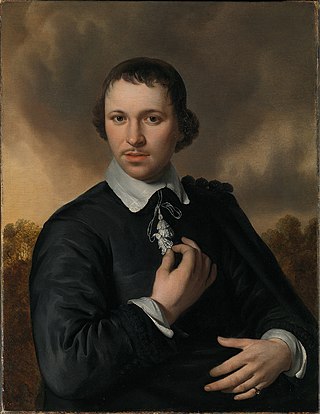
Jan van de Cappelle was a Dutch Golden Age painter of seascapes and winter landscapes, also notable as an industrialist and art collector. He is "now considered the outstanding marine painter of 17th century Holland".

The auricular style or lobate style is a style of ornamental decoration, mainly found in Northern Europe in the first half of the 17th century, bridging Northern Mannerism and the Baroque. The style was especially important and effective in silversmithing, but was also used in minor architectural ornamentation such as door and window reveals, picture frames, and a wide variety of the decorative arts. It uses softly flowing abstract shapes in relief, sometimes asymmetrical, whose resemblance to the side view of the human ear gives it its name, or at least its "undulating, slithery and boneless forms occasionally carry a suggestion of the inside of an ear or a conch shell". It is often associated with stylized marine animal forms, or ambiguous masks and shapes that might be such, which seem to emerge from the rippling, fluid background, as if the silver remained in its molten state.

Adam van Vianen was a leading silversmith of the early Dutch Golden Age, who trained as an engraver and was also a medallist. Unlike his brother Paul van Vianen, he spent little time away from his native Utrecht. Together they developed the auricular style which bridges the gap between Northern Mannerist and Baroque ornament.

The Serenade is a 1629 oil painting by Judith Leyster in the collection of the Rijksmuseum. It was attributed for centuries to Frans Hals until Wilhelm von Bode saw it in the Six collection in 1883. He noticed the prominent "J" in the signature, and attributed it to Jan Hals. This is one of seven paintings first properly attributed to Leyster by Hofstede de Groot ten years later in 1893.

Isaac Blessing Jacob is a 1642 religious painting by Gerbrand van den Eeckhout. It shows Jacob kneeling at the bed of his blind father Isaac under the watchful eye of his mother Rebecca as he receives his brother Esau's blessing. It is in the collection of the Metropolitan Museum of Art.

The Continence of Scipio is a c. 1653 painting by Dutch artist Gerbrand van den Eeckhout. It shows the continence of Scipio and is now in the collection of the Rijksmuseum in Amsterdam.
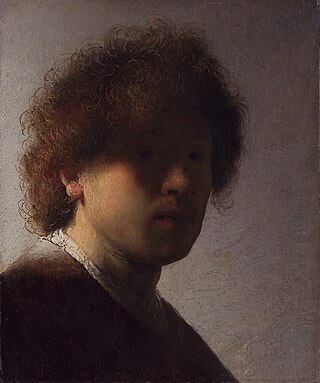
Vereniging Rembrandt is a Dutch association of art patrons who raise funds to assist Dutch museums and art galleries in purchasing artworks. Since it was founded in 1883, it has helped purchase over two thousand works, including Vermeer's The Milkmaid.

The Adoration of the Magi is a 1517 triptych by the Early Netherlandish painter Jacob Cornelisz. van Oostsanen in the collection of the Rijksmuseum.

The Adoration of the Shepherds is a 1607 silver plaquette by the Dutch Golden Age sculptor Paulus van Vianen in the collection of the Rijksmuseum.


